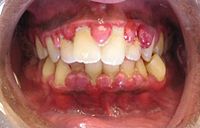
Photo from wikipedia
Összefoglaló. Bevezetés és célkitűzés: A gingivahyperplasia a kalciumcsatorna-blokkoló gyógyszerek gyakori mellékhatása. Eredményeink közlésének célja, hogy bemutassuk, sebészi terápia nélkül, megfelelő egyéni szájhigiénia kialakításával és nem sebészi parodontalis terápiával milyen eredményt… Click to show full abstract
Összefoglaló. Bevezetés és célkitűzés: A gingivahyperplasia a kalciumcsatorna-blokkoló gyógyszerek gyakori mellékhatása. Eredményeink közlésének célja, hogy bemutassuk, sebészi terápia nélkül, megfelelő egyéni szájhigiénia kialakításával és nem sebészi parodontalis terápiával milyen eredményt tudunk elérni az ínymegnagyobbodás kezelése során. Módszer: A Szegedi Tudományegyetem Fogorvostudományi Karának Parodontológiai Tanszékén 2015 és 2019 között 10 - 7 nő és 3 férfi, átlagéletkoruk 56 év (50-69 év) volt -, kalciumcsatorna-blokkoló gyógyszer szedése során kialakuló, Grade III. ínyhyperplasiában szenvedő páciens kezelését végeztük konzervatív parodontalis módszerekkel, a gyógyszercsere mellőzésével. A legfontosabb parodontalis értékeket rögzítettük, a tasakmélység, a vérzési index, a plakkindex és a fogmozgathatóság értékeit összegeztük vizsgálatunkban. A parodontium destrukciója mértékének megállapításához ortopantomogram és periapicalis röntgenfelvételeket értékeltünk. Eredmények: Minden parodontológiai paraméterben jelentős javulást tapasztaltunk. A nem sebészi parodontalis terápia eredményeként megszűnt az elváltozás mind a 10 betegnél, és a szigorú fenntartó terápiának is köszönhetően nem is újult ki. Következtetés: A nem sebészi terápia alkalmasnak bizonyult a súlyos gingivahyperplasia definitív kezelésére, ha az gingivitis vagy enyhe és középsúlyos parodontitis talaján alakult ki. Arra is következtethetünk az eredményeinkből, hogy a gyógyszeres terápia megkezdése előtt vagy azzal párhuzamosan parodontológiai terápiában részesülő páciensek nagy részénél a gingivahyperplasia - s ezzel a hosszú ideig tartó, drága kezelés - megelőzhető lenne. Orv Hetil. 2022; 163(13): 506-512. SUMMARY INTRODUCTION AND OBJECTIVE Gingival overgrowth is an adverse drug reaction in patients on long-term calcium channel blocker therapy. The aim of this study was to assess the efficacy of non-surgical pocket therapy in patients suffering from Grade III drug-related gingival overgrowth. METHOD 10 (7 female and 3 male) patients (age between 50-69 years) diagnosed with severe, Grade III gingival overgrowth were treated in our department. Non-surgical periodontal therapy consists of improving of individual oral hygiene, scaling, polishing and subgingival mechanical debridement instrumentation. The main periodontal parameters (probing pocket depth, bleeding index, plaque index and mobility) were scored in this study. Bone loss was evaluated by orthopantomograms and periapical radiographs. Calcium channel blockers have not been replaced by any other medications during the whole course of periodontal treatment. RESULTS Compared with baseline parameters, all scores improved after therapy. All patients showed decrease in the average probing pocket depth, deepest probing pocket depth, bleeding scores, plaque scores and tooth mobility. None of the patients needed further surgical treatment. In our followed-up patients, recurrence of gingival overgrowth has not been observed during the two-year meticulous supportive periodontal care in the patient group. CONCLUSION Non-surgical periodontal treatment can be a potential definitive therapy in Grade III gingival overgrowth associated with gingivitis or moderate periodontitis. Periodontal screening and treatment before or simultaneously with the administration of calcium channel blockers can prevent the gingival enlargement in the majority of patient. These results outline the importance of the successful cause related periodontal therapy, started before or simultaneously with the administration of anithypertensive medications and in this way a series of further expensive therapies could be anticipated. Orv Hetil. 2022; 163(13): 506-512.
Journal Title: Orvosi hetilap
Year Published: 2022
Link to full text (if available)
Share on Social Media: Sign Up to like & get
recommendations!